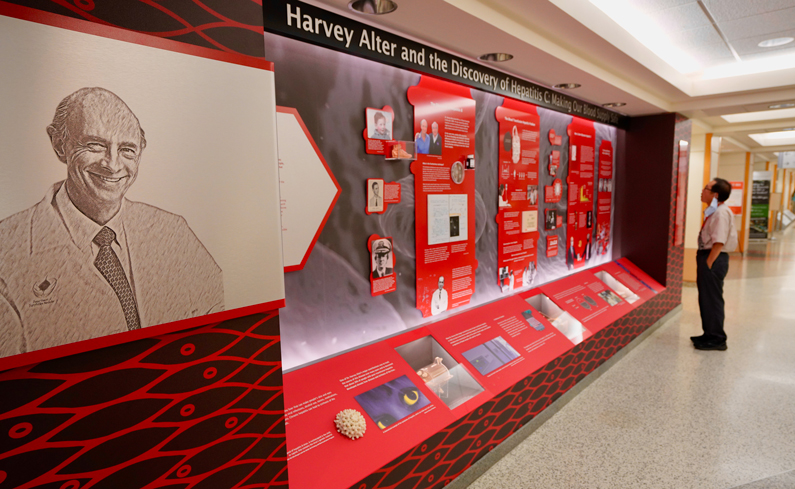New CC exhibit honors Dr. Harvey Alter
An installation by the NIH Office of History and Stetten Museum tells the story of the 2020 Nobel laureate and his discovery of the hepatitis C virus

If you've never encountered the career of Dr. Harvey Alter, 87, the distinguished physician-scientist and virologist in the NIH Clinical Center's Department of Transfusion Medicine, a new exhibit tells the fascinating story of his discovery of the hepatitis C virus and his work to make our blood supply safe.
For those familiar with Alter's research, the installation offers fresh delights, including objects and ephemera such as his homemade phlebotomy kit (a wooden lantern slide box with a luggage handle screwed to the top) and his 2022 poem, "I Never Had No Nobel Dreams" (self-effacing, humorous and true to character).
Central to Alter's story are the many scientists, patients, and blood donors who contributed to his life-saving discoveries. "I owe everything to these collaborators," he is quoted as saying. The exhibit spotlights some of these figures, including Dr. Baruch Blumberg, Dr. Paul Holland, a clinical trial participant dubbed Patient H, and Doris Wong. Wong, for example, was a National Institute of Allergy and Infectious Diseases microbiologist and laboratory manager, who helped develop many of the early tests for hepatitis.
The exhibit was produced by Michele Lyons, Devon Valera and Mark Riewestahl of the Office of NIH History and Stetten Museum. On a recent morning, Lyons walked a visitor through the space, pointing out Alter's favorite piece in the exhibit. It's a bar graph titled, "Cases of Post-Transfusion Hepatitis (1965–2000)." Before the 1970s, nearly one in three patients who received multiple blood transfusions contracted hepatitis. By the 2000s, that number was basically zero. "He loves the swoop," Lyons says.
Alter's research was instrumental in shaping that swoop. He helped discover another hepatitis virus, hepatitis B, and urged blood banks to source blood from volunteer donors not commercial ones. A related discovery was that HIV could be transmitted by donated blood from asymptomatic carriers.
Alter's career has been long and illustrious. The exhibit occupies a wall space a mere ten paces wide. A challenge was how much material and context had to be left out, Lyons says. She points to the NIH Clinical Center's role as a leading center for heart surgery in the 1960s and 70s, where patients of that era required multiple blood transfusions and often contracted hepatitis.
Alter changed that. And where the NIH Clinical Center went, Lyons says, so followed the country and the world.
"Harvey Alter and the Discovery of Hepatitis C: Making Our Blood Supply Safe," is now on view in the central corridor of the Magnus Building of the NIH Clinical Center, near the FAES coffee shop. A ceremony and reception will mark its official opening on Sept. 7. Likely speakers include NIH Acting Director Dr. Lawrence Tabak and Clinical Center CEO Dr. James Gilman.
Alter will also attend. Given his humble nature and distaste for the spotlight, Lyons, the exhibit's curator, offers a prediction about the hoopla and how it will square with her subject: "He'll hate it."
— Sean Markey